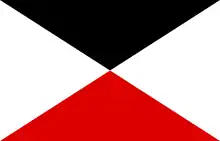Naval Corps (German Empire)
The Naval Corps (German: Marinekorps) was a corps formation of the German Empire in World War I. It was formed in November 1914 and was still in existence at the end of the war.[1]
| Naval Corps (Marinekorps) | |
|---|---|
 Flag of the Staff of a Generalkommando (1871–1918) | |
| Active | 20 November 1914-1919 |
| Disbanded | 1919 |
| Country | |
| Engagements | World War I |
Chronicle
The Naval Corps was formed on 20 November 1914 to command the land-based forces of the Imperial German Navy operating in Flanders. It was continuously based on the extreme right wing of the German line on the Western Front, up against the North Sea. It commanded the 1st Naval Division and 2nd Naval Division also including 3rd Naval Division throughout; one division held the land front, the other the sea front.
It was still in existence at the end of the war[2] in the 4th Army, Heeresgruppe Kronprinz Rupprecht on the Western Front, still holding the extreme right of the line. It had the following composition:[3]
- 1st Naval Division
- 2nd Naval Division
- two thirds 38th Landwehr Division[4]
- one third 3rd Division[5]
- 85th Landwehr Division
Order of battle
MarineKorps Flandern
– Admiral Ludwig von Schröder
1. Strength at the end of 1918:
1st MarineDivision
– 1st Marine-Brigade
1st Seabattalion
2nd Seabattalion
3rd Seabattalion
– 2nd Marine-Pionier-Battlion
– 1st Pioneer Kompanie
– 2nd Matrosen-Artillerie-Regiment
– 3rd Piooner Strumtrupen Kompanie
2. Strength at the end of 1918:
– 3rd Marine-Brigade
– 1st Schwere Waffen Kompanie
– 2nd Schwere Waffen Kompanie
– 3rd Marine Regiment
– 1st Marine-Feldartilleriebatterie
– 4th Marine-Brigade
– 2nd Marine-Feldartilleriebatterie
– 4th Matrosen-Regiment
–3rd Marine-Pionier-Kompanie
3. Strength at creation on July 1, 1917
3rd MarineDivision
– Marine-Infanterie-Brigade
– 9th Feldartillerie-Regiment
– 1st Marine-Infanterie-Regiment
– 115th Pioniere-Batallion
– 2nd Marine-Infanterie-Regiment
– 1st Reserve-Kompagnie, 24th Marinebattalion
– 3rd Marine-Infanterie-Regiment
– 3rd Eskadron
– 160th Minenwerfer-Kompagnie
– 7th Husaren-Regiment
Commanders
The Naval Corps was commanded throughout its existence by Admiral Ludwig von Schröder, brought out of retirement.[6][7]
See also
References
- Cron 2002, pp. 88–89
- Cron 2002, pp. 88–89
- Ellis & Cox 1993, pp. 186–187
- The remaining third of 38th Landwehr Division was assigned to the adjacent Guards Reserve Corps.
- The bulk of 3rd Division was assigned to the adjacent Guards Reserve Corps.
- "German War History". Retrieved 1 November 2012.
- "Biography on The Prussian Machine". Archived from the original on 20 December 2012. Retrieved 1 November 2012.
Bibliography
- Cron, Hermann (2002) [1937]. Imperial German Army 1914–18: Organisation, Structure, Orders-of-Battle. Solihull: Helion. ISBN 1-874622-70-1.
- Ellis, John; Cox, Michael (1993). The World War I Databook. London: Aurum Press. ISBN 1-85410-766-6.
- Karau, Mark (2003). "Wielding the Dagger": The MarineKorps Flandern and the German War Effort 1914–1918. Contributions in Military Studies. 226. Westport, CT: Praeger. ISBN 0-313-32475-1.
